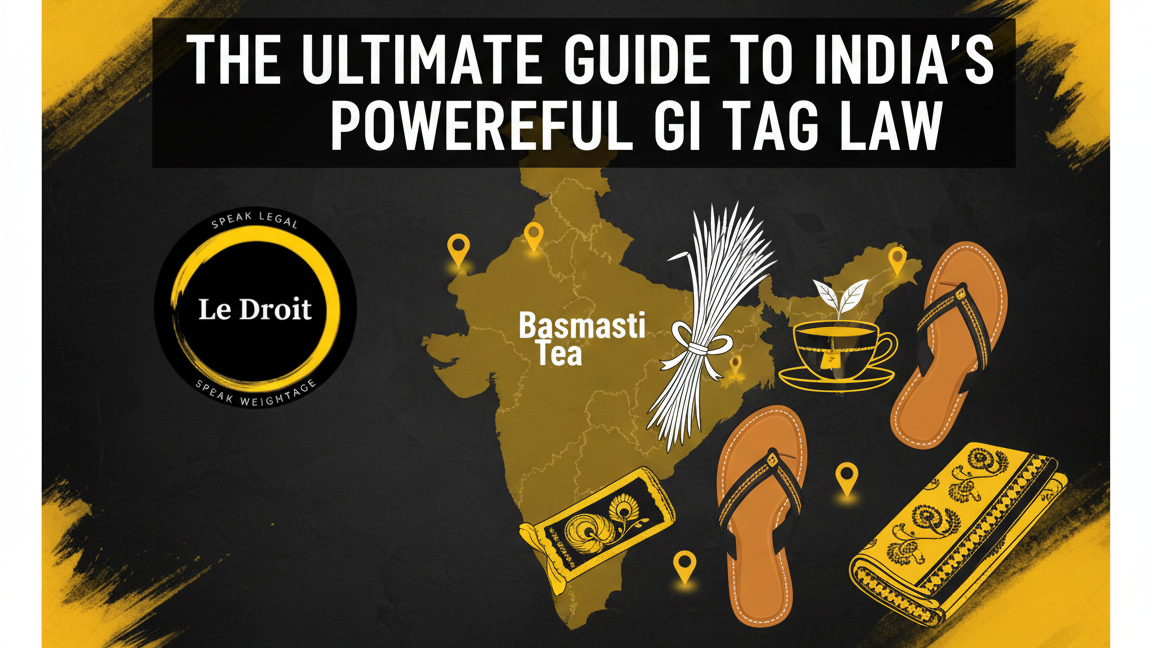This article is written by Kimaya Anavkar, a T.Y.LL.B. student at Kishinchand chellaram Law College.

ABSTRACT
The Geographical Indication (GI) tag is a powerful form of Intellectual Property Rights (IPR) that legally protects the legacy of iconic products like Darjeeling Tea and Basmati Rice. This article delves into the legal framework of GI tags under India’s Geographical Indications of Goods Act, 1999, exploring why a name linked to a place matter so much. Through landmark legal battles involving India’s most treasured products, we will illustrate the crucial role GIs play in safeguarding our national heritage, ensuring authenticity for consumers, and securing economic justice for producers.
This piece clarifies the legal distinction between a GI tag and a trademark, providing a comprehensive look at how this unique IPR tool protects the very soul of our cultural and natural treasures.
Keywords
Geographical Indication, GI Tag, Intellectual Property Rights, Indian Heritage, The Geographical Indications of Goods Act 1999, Basmati Rice, Darjeeling Tea.
INTRODUCTION: WHAT DO CHAMPAGNE AND KANCHIPURAM SILK HAVE IN COMMON?
Have you ever wondered why true “Champagne” can only come from a specific region in France? Or why do we intrinsically link an authentic “Kanchipuram Silk Saree” to the weavers of a single town in Tamil Nadu? The answer lies in a powerful legal protection known as a Geographical Indication, or GI tag.
A GI tag is more than just a label; it’s a legal testament to a product’s origin, quality, and reputation. It certifies that a product possesses certain qualities or that producers make it according to traditional methods exclusive to its geographical birthplace. In India, these invaluable rights are protected under
The Geographical Indications of Goods (Registration and Protection) Act, 1999. This law serves as a guardian for our collective heritage, ensuring that the legacy tied to a place remains authentic and protected.
THE BATTLE FOR AUTHENTICITY: LANDMARK GI CASES
Producers and countries often fight to protect a GI in courtrooms around the world. These legal battles highlight just how valuable and contested these geographical names can be.
The Basmati Rice Saga
One of the most famous GI disputes involved Basmati rice. In 1997, a patent office granted a Texas-based company, RiceTec Inc., a patent on certain rice lines, and the company made claims on the name “Basmati.” This was a direct threat to India and Pakistan, where Basmati rice has been grown for centuries.
India mounted a significant legal challenge, arguing that no one can invent “Basmati” rice and that the unique agro-climatic conditions of the Indo-Gangetic plains intrinsically link the name to the product. After years of legal proceedings, RiceTec withdrew its broader claims on the name. This case was a watershed moment, demonstrating that a Geographical Indication is a collective community right that cannot be usurped by a private entity. It underscored the need for strong domestic laws, leading to the enactment of the GI Act in India.
Protecting Darjeeling’s “Champagne of Teas”
The Tea Board of India has been extremely proactive in protecting the Darjeeling Tea GI. The name “Darjeeling” and its accompanying logo are protected not only in India but in numerous other countries.
The Board has fought and won several cases against infringement. For example, it has legally challenged and stopped companies in countries like Japan, France, and Russia from using the name “Darjeeling” for tea not sourced from the 87 designated tea gardens in the region. These cases reinforce a crucial legal principle: a GI tag provides the right to prevent anyone from using the name in a way that misleads the public about the true origin of the product. It’s a fight for authenticity that protects both the consumer and the thousands of workers whose livelihoods depend on Darjeeling’s unique tea.
WHY GI TAGS ARE A LEGAL SHIELD FOR EVERYONE
The GI framework provides a robust legal and economic shield that benefits all stakeholders.
- For Producers: A GI tag is a bulwark against infringement. It gives the community of producers the exclusive right to use the name, allowing them to command a premium price and protecting them from cheap imitations. This fosters economic prosperity and preserves traditional skills that might otherwise vanish.
- For Consumers: It acts as a legal guarantee of authenticity. When you purchase a product with a GI tag, you are assured of its quality and origin. This prevents deception in the marketplace and ensures you get what you pay for.
- For the Country: GIs are a cornerstone of a nation’s cultural and economic identity. They preserve Indian Heritage and traditional knowledge while boosting exports and tourism. By legally protecting these names, we are telling the world that our heritage has immense value.
GI TAG VS. TRADEMARK: A KEY LEGAL DISTINCTION
While both are forms of Intellectual Property Rights, they serve different legal purposes.
A Trademark protects a brand and is owned by a single person or company (e.g., “Tata”). A GI Tag protects a name linked to a place and is owned by a community of producers (e.g., “Darjeeling”). A trademark is an individual right; a GI is a collective one.
| Feature | Trademark | Geographical Indication (GI) |
| Ownership | An individual or a company. | A community or association in a specific region. |
| Protects | A brand’s unique name/logo. | A product’s link to its place of origin. |
| Right Type | Private/Individual Right | Collective/Community Right |
CONCLUSION: MORE THAN JUST A NAME
As the legal battles for Basmati Rice and Darjeeling Tea show, a Geographical Indication is far more than just a name—it’s a legacy, a promise of quality, and a vital economic tool. The GI Tag system in India is a testament to the importance of protecting our collective Intellectual Property Rights. By recognizing, celebrating, and legally defending these unique products, we ensure that our rich Indian Heritage continues to thrive, benefiting the communities that are its rightful custodians and the consumers who cherish authenticity.
FREQUENTLY ASKED QUESTIONS (FAQS)
1. Can anyone use a GI tag?
No. The law legally allows only authorized producers from the specific geographical region to use the GI tag on their products.
2. Is a GI tag permanent?
The Registry grants a GI tag for 10 years, and producers can renew it for subsequent 10-year periods, thereby protecting it indefinitely.
3. What is the main difference between a GI tag and a trademark?
A trademark belongs to one company, while a GI tag belongs to a whole community or region of producers.
4. What happens if someone fakes a GI product?
Selling a fake product with a GI tag is a punishable offense under Indian law, which can lead to fines and even imprisonment.
5. How can I check if a product has a real GI tag?
Look for the official GI tag logo on the product’s packaging. You can also verify the product’s status on the official website of India’s Geographical Indication Registry.
6. Who grants the GI tag in India?
The Geographical Indication Registry, which is part of the Department for Promotion of Industry and Internal Trade in India, grants the GI tag.
7. Does every famous local product automatically have a GI tag?
No. An association of producers must formally apply and go through a legal registration process to get a GI tag for their product.
8. Why is the GI tag so important for farmers and artisans?
It helps them get a better price for their genuine products and legally protects them from fakes, which secures their income and preserves their traditional skills.
